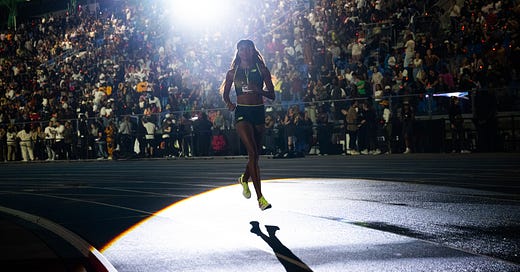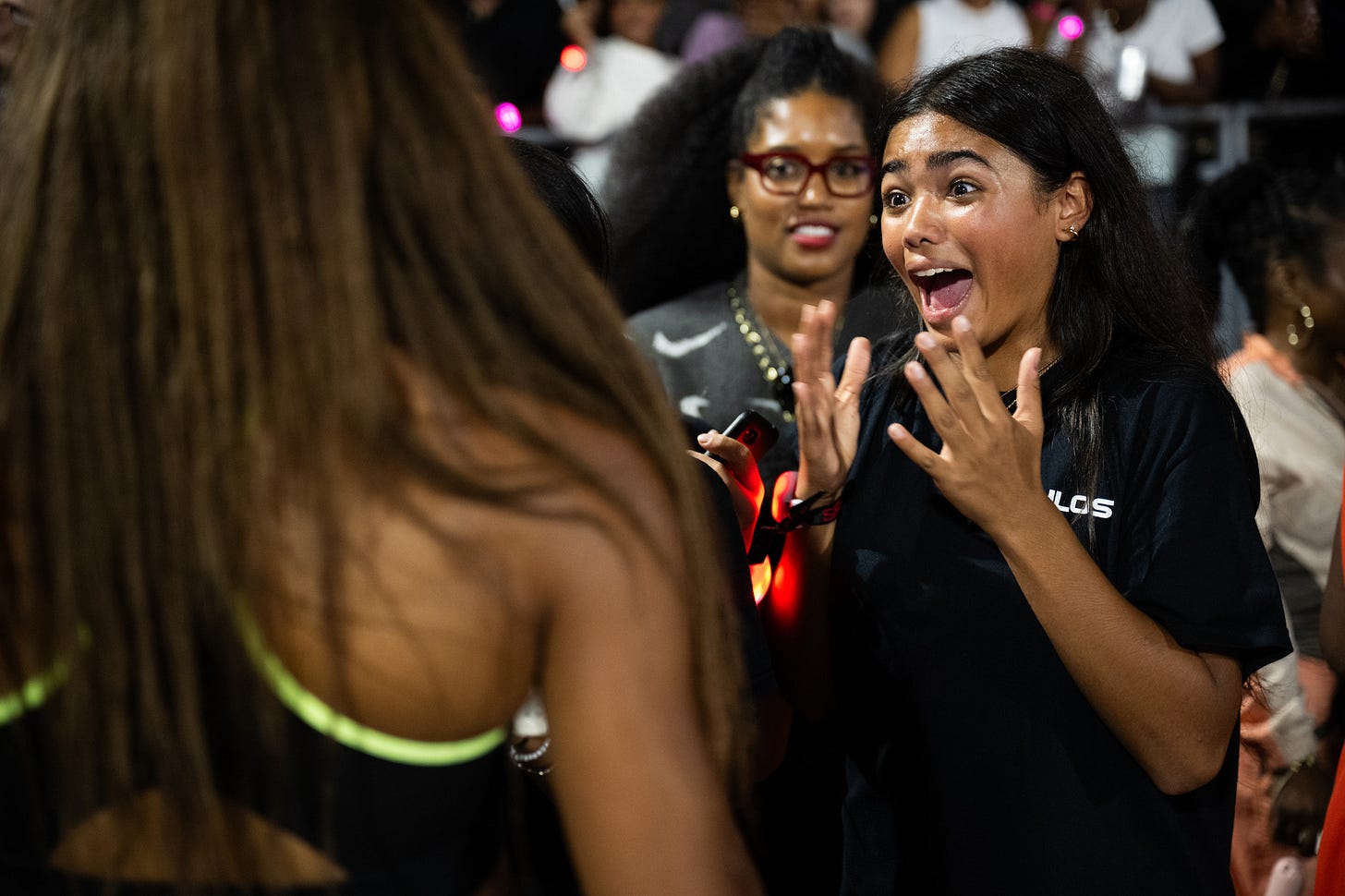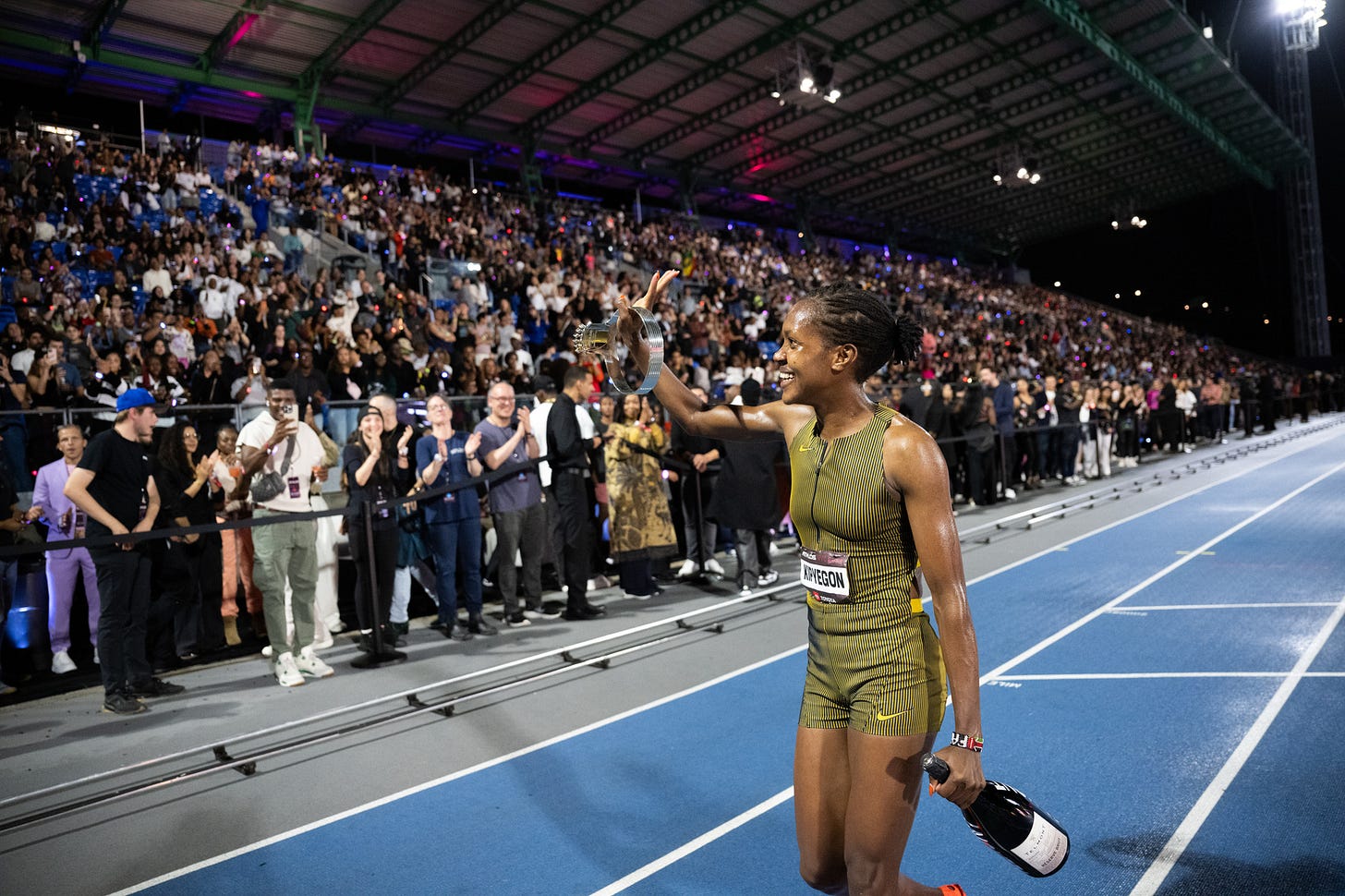A Night at the Track
What does it mean—for the sport and for the athletes—to host a women's only track meet and offer the highest prize purse in history?
One quick thing before we get into today’s newsletter.
I’m speaking at an event in Boston on October 17 on how design and policy help build a safer, more hospitable “field of play” for women athletes. I’ll be joined by Lauren Scruggs, who won Olympic gold and silver in Paris and is the first Black American woman to win an individual fencing medal, and Jamie Mittelman, the founder of Flame Bearers, a media production and content company for elite women athletes.
It’s free and you can RSVP here.
Details: October 17, 5pm - 6:30pm at The Node, Science and Engineering Complex, 150 Western Avenue Boston, MA 02134
Like many things, it all started with a rage tweet.
In 2019, Alexis Ohanian, aka Serena Williams’ husband and co-founder of Reddit, ranted that women’s sports was undervalued. He couldn’t believe that Seattle Reign FC, the National Women’s Soccer League team in Seattle sold for only $3.5 million when he thought its star player, Megan Rapinoe, was worth at least that alone. It led to his investment in Angel City FC, which now has the highest valuation in the league.
And his latest investment is Athlos, a highly produced, women’s only track meet with the highest prize purse in history. On Thursday, September 26, 36 of the fastest women (they have 30 Olympic medals between them) compete in six events, ranging from the 100m to the 1500m plus the 100m hurdles.
Every lane won prize money, from $2,500 for sixth place to $60,000 for first. The winner took home double the amount awarded to the winner of the Diamond League final, the culmination of the sport’s current circuit for elite athletes.
But he says that his investment isn’t about charity and it isn’t about doing “the right thing” or “the nice thing.” He looks at women’s sports from purely a business perspective and he thinks there’s a lot of upside. After all, Deloitte forecasted that women’s sports will surpass $1 billion in revenues this year, which is 300% higher than its forecast three years ago.
Running needs an infusion of energy to help grow the sport and sometimes you need to do things differently. We’ve seen some innovative models this year like the 1v1 race between Mondo Duplantis, Olympic gold medalist and world record holder in the pole value, and Karsten Warholm, Olympic gold medalist and world record holder in the 400m hurdles. They raced a 100m exhibition at the beginning of September and it generated a lot of excitement.
And since Ohanian first announced Athlos in April, others have followed suit and invested in the sport. Olympic gold medalist Michael Johnson announced his new elite league, Grand Slam Track, which will debut in spring 2025. Athletes race four times a year and have a chance to win $400,000 in prize money over the season.
Then, eight days before the Athlos meet, the Diamond League announced that they were increasing their prize money for next season, on par with Athlos and Grand Slam Track.
The sport needed this.
Athlos didn’t feel like a regular track meet and that was the point. It was billed as “unprecedented.” Coachella meets track. A cultural moment that highlights the intersection of sports, music, and fashion. A stop on rapper Megan Thee Stallion’s tour. (There was at least one fan in attendance who didn’t realize it was a track meet until she arrived, according to this Runner’s World article. The date was listed as a regular stop on Meg’s tour schedule.)
Ohanian said that he wanted to capture the energy of the night matches at the U.S. Open, which can get rowdy and run into the early morning hours. These matches attract die-hard tennis fans as well as those new to the sport.
I got to attend the meet on behalf of SELF. I have to admit, I was nervous at first. Were people going to pay for tickets? Were they going to schlep out to Randall’s Island? (Honestly, I didn’t want to schlep out to Randall’s Island!) Early in the evening, the stands looked about 60% full.
But people showed up. Sure, there were some hiccups on site but overall, the event delivered.
{For more vibes, here’s a story and photo essay for SELF that I wrote.}
“People only know about track during the Olympics. Now that there are meets that are incorporating outside things to draw the regular general public to these meets, it’s like alright. This isn’t just an every four-year thing. This is a job that people are doing on a consistent basis that you want to watch and tune in and possibly invest in.” - Masai Russell, Olympic gold medalist in the 100m hurdles
The event was centered on the athletes from the very beginning.
This was intentional. When Ohanian wanted to learn more about track and field, he talked to the athletes and others in the sport and he took their ideas to heart. “That’s not something you see in sport every day, the people who are pulling the strings actually including athletes in decision making,” Olympic gold medalist Gabby Thomas told me. “Alexis called me before this was even a possibility of a thought.”
And those ideas were translated into reality from the prize money to smaller adhesive bibs that actually fit the torso of women to the mostly-women broadcast team to the female race starter to the pyrotechnics and walkout tunnel to athlete introductions so that people actually knew who was racing and why they should care to getting Megan Thee Stallion to close out the night. The women were treated like stars.
Change is in the air.
“Track is kicking down the door,” said Masai Russell, who won the Olympic gold medal in the 100m hurdles. She talked about how more athletes are speaking up and it’s unveiling aspects of the sport that aren’t the best. “There’s so much more that could be done in this space and people are speaking out about it,” she said. “I’m just glad that people in the sport and outside of the sport are starting to understand that.”
Thomas said, “We’ve been wanting this for so long now and now we have the support to make it happen. It’s a special time for track and field.”
Prize money was the hook.
When I asked athletes why people wanted to be part of this event and extend their already long, high-stakes season until the end of September, the athletes I spoke with were pretty upfront. The money.
“A lot of times, athletes can’t afford to race. You’re just paying attention to the top 1% of athletes who are competing but there are a lot more who can’t afford to do all this,” Thomas said. “It’s important that we have opportunities to make a living.”
But it’s hard to do that when the prize money is a couple thousand dollars if you podium or you rely on appearance fees, which requires a big name and/or big results.
“We’re coming all the way overseas to run for—you’ve all seen the prize money. And that’s the winner and the winner doesn’t even get all that. You’ve got to pay your agent. You’ve got to pay your coach. You don’t even see the whole thing,” two-time Olympic medalist Jamine Camacho-Quinn said ahead of the race. Camacho-Quinn walked away from Athlos with $60,000 for winning the 100m hurdles.
Olympic bronze medalist Brittany Brown was the big winner on Thursday night. She raced the 100m and 200m, placing second and first, respectively, and earned a total of $85,000.
Being an unsponsored athlete wasn’t a bad thing.
Usually, athletes who don’t have a sponsor or are between sponsors are a minority at big meets and there’s this sense that it’s a bad thing, that it somehow means you’re not good enough because if you were, you’d have a sponsor. But at Athlos, there didn’t seem to be that negative stigma because the focus was on the athletes and their performance on the track.
“Everybody is trying to say ‘They’re the most fashionable,’ but you can’t be the most fashionable if you have to wear what everybody else has to wear,” Olympic hurdler Alaysha Johnson told media the day before the race. “For me and the other unsponsored athletes, it’s making it fun again. It’s making it have a sense of value like where we can have camaraderie about being unsponsored and it’s not this super negative thing.”
Johnson also said that Athlos brought new opportunities to the table and be seen by companies that may not typically work with track athletes. She got to participate in a special collaboration with Ryoko Rain, which other athletes might not have been able to do because of their sponsorships. She also wore a custom denim-inspired kit from Diesel, inspired by their summer-spring 25 fashion show.
Athletes were able to bring more of themselves to the event.
I love that we are seeing athletes bring more of their personality and style to the athletic arena because athletes are human beings, not just race times or points scored. Athletes entering Icahn were treated to a red carpet walk-in where they showed off their fashionable styles a la the pre-game WNBA tunnel walk.
“There’s not that many opportunities [to bring in your personality] in the sport, especially when you’re wearing a brand,” Olympian and 800m runner Nia Atkins told me. “I’m kind of in this no man’s land where I’m in between one sponsor and hopefully another so it’s been really cool to just come out here and be myself.”
Athletes I spoke with saw the blending of fashion and sport as an opportunity to bring in a new audience and build a new fan base for the sport. I loved that hurdler Tonea Marshall wore pieces from the Naomi Osaka x Nike collaboration. “I really wanted to do something really girly that represented women. Naomi Osaka is really strong in women’s sports and I wanted to bring her here,” she told me. “I wanted to jazz it up with some jewelry and make athletic wear look fashionable.”
The event was made for online sharing.
I mean, this shouldn’t come as a surprise, seeing as the event was conceptualized by the co-founder of Reddit. Ohanian told me that he wanted Athlos to be something that people wanted to be part of, that people wanted to talk about and share.
“Everything we're building usually starts we work backwards from the the image or the video that can go viral,” he said. “What those end up being are about our athletes and being able to share their excellence, share their stories and the story at the actual meet in a way that really resonates.”
Because, as Ohanian explains, that’s where the younger generation hangs out—online and on social media. If you want to grow the sport, you need to generate buzz and attract new fans. And it was fun to see the athlete get the rock star treatment complete with screaming fans, glam sessions, and photo shoots.
It’s notoriously hard (and can be expensive) to watch track and field meets and limited coverage of events limits the fandom. But the fans are there as evidenced by the popularity of track and field at the Olympics. By making Athlos accessible—it streamed live on YouTube, X, ESPN+, and DAZN and a replay on ESPN2 on Saturday—more people could watch. I don’t think that the final numbers have been released by the last I saw Monday mid-day, there were 2.5 million views on X and 86,000 views on YouTube.
When I spoke with Ohanian the day before the event, I asked what’s next. He answered that the hard work started the day after the meet and they needed to earn the right to come back. Well, he’s since said that he wants to make Athlos a fixture on the New York sports scene.
Still, there are a lot of open questions. Yes, it was a successful evening but how do you make it sustainable? How do you fit it into the competition schedule? How do you decide who will compete because not everyone can compete?
I’m curious to see how it will play out. I’m curious to see if events like these will grow the fan base and will draw more investment into the sport.
Either way, I’m glad that they pulled it off. I’m glad that the highest purse offered in track started at a women’s-only event.
Thanks for reading. More soon.
Christine









Prize money seems like easy win-win marketing budget!